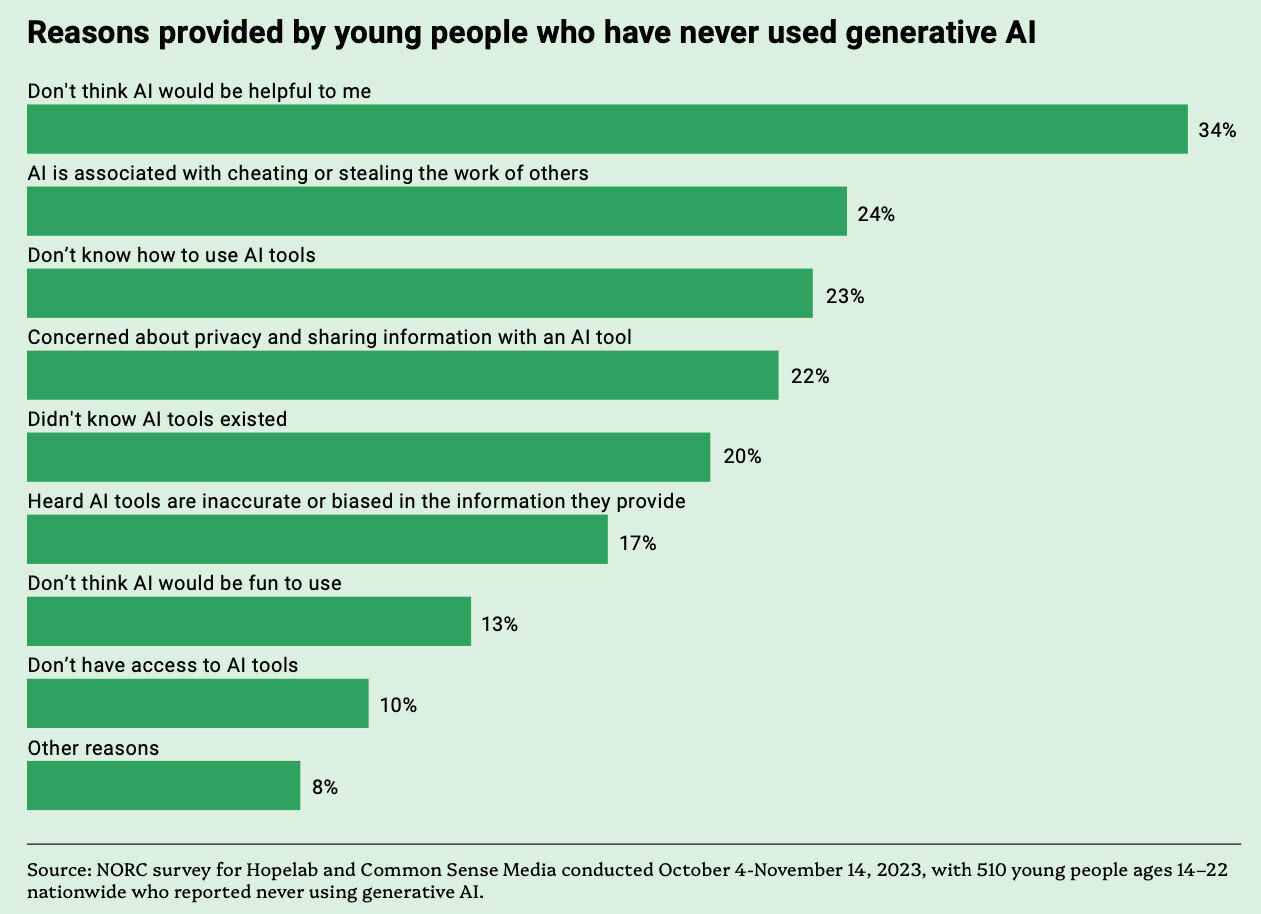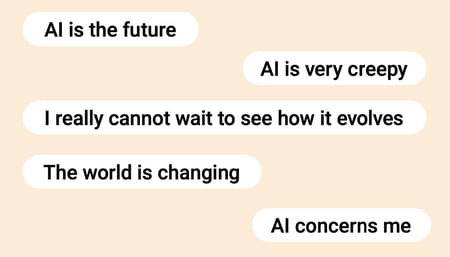 Fascinating research via Hopelab and the Center for Digital Thriving at Harvard Graduate School of Education examining how young people perceive and interact with generative AI technologies show very slow adoption of this transformational technology. I think our educational system is to blame for not bringing AI into the classroom.
Fascinating research via Hopelab and the Center for Digital Thriving at Harvard Graduate School of Education examining how young people perceive and interact with generative AI technologies show very slow adoption of this transformational technology. I think our educational system is to blame for not bringing AI into the classroom.
The report Teen and Young Adult Perspectives on Generative AI: Patterns of Use, Excitements, and Concerns finds that nearly half (49%) of young people ages 14-22 have either never used generative AI or do not know what the tools are. Only 11% use AI once or twice a week and 4% report being daily users.
We’ve been here before.
When I was a kid, electronic calculators were introduced. Throughout my school years, calculators were banned in classrooms, we could only solve math problems with a pencil and paper.
Not just plagiarism
Then in the 1990s and 2000s, the Web made information widely available to anybody with access to an internet connection. Rather than teach students how to be smart information consumers, most educational systems simply banned all use of Web content for schoolwork.
Gasp! Anybody could update Wikipedia or start a blog! So much unverified information! It was deemed better to go to the school library to find a few often-dated books on a topic than tap the vast resources of all the world’s knowledge.
Sure, there is false and misleading information on the web.
Rather than hiding, we should have been teaching students how to understand and use electronic information. How much better off would society be had we taught people about different media sources, how to think critically about them, and how to make up their own minds.
And now we have AI, perhaps the most transformational technology ever invented.

According to the study, of the young people who have never used generative AI, one-third (34%) think it would not be helpful. Clearly, this is a failure of understanding as AI can be helpful to anyone.
The sad truth is many educators still believe that all AI use is just plagiarism. Few understand that generative AI apps like Perplexity, ChatGPT, and Google Gemini are much more than just a place to create an entire essay, which is how most of them first encountered the tools.
Yes, we don’t just want young people to ask ChatGPT to do write their homework assignment. However, there are so many valuable ways that students can use the technology.
An important aid to critical thinking
We should be teaching young people how generative AI can help them!

I was about to think up a bunch of ways students can make use of AI. That would have taken 10 or 15 minutes, and the list would have been incomplete. Instead, I just asked Perplexity how generative AI can help students and, in a few seconds, I got a way better answer than if I had tried to think of the ways myself.
Via Perplexity, here’s some ways that generative AI can help students:
- Assist with studying and comprehension: AI tools can summarize complex texts, explain difficult concepts in simpler terms, and generate practice questions to aid understanding.
- Improve writing skills: These tools can provide instant feedback on grammar, syntax, and style, helping students refine their writing abilities.
- Generate ideas and aid brainstorming: AI can suggest new ideas and perspectives, sparking creativity and helping students overcome writer's block.
- Personalize learning experiences: AI tools can adapt to individual learning styles and knowledge gaps, providing tailored explanations and practice materials.
- Enhance language learning: For language learners, AI can serve as a conversation partner for practice and provide immediate grammatical assistance.
- Support research tasks: AI can help analyze large datasets, identify patterns, and generate insights for research projects.
- Increase accessibility: These tools can aid diverse learners with different abilities, linguistic backgrounds, or accessibility needs.
- Provide instant feedback: Students can receive immediate responses to questions or get feedback on their work, allowing for faster learning and improvement.
- Assist with time management: AI tools can help students be more efficient with coursework and tasks, potentially improving productivity.
- Offer multiple perspectives: AI-generated outputs can provide various viewpoints on a topic, enriching students' understanding and encouraging critical thinking.
In episode 100 of the fabulous Marketing AI Institute podcast, co-host Paul Roetzer offers the following:
“Intro to AI should be a required course for every first-year college student. How can AI be a part of every assignment? …Teach people how to use AI, but make sure students are thinking critically about the outputs they’re getting. This is what’s going to be asked of them in the real world. The sooner we teach them how to work with the tools, the more capable they will be when they get into the professional world.”
Paul’s right. And as he also said, we should be teaching AI to younger kids too, in high school, middle school, and even elementary school.
At the recent US Presidential debate, I was waiting for a question on generative AI, a transformational technology affecting all aspects of society. Yet no question was asked of the candidates.
If government, the media, and educators are slow to respond, it’s up to all of us: Parents, relatives, and concerned citizens to ensure that AI is taught in schools. Ask about AI when you meet with your kids’ teachers. If they don’t have a good response, go to the principal or school board. Offer to teach them what you know.
Disclosure: I’m an investor in the Marketing AI Institute.
